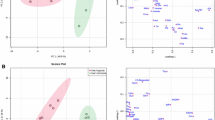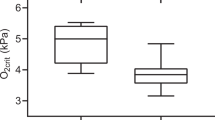Abstract
ASPHYXIA, anoxia and hypoxia occur only when the ambient oxygen and carbon dioxide in water reach threshold level. Lethal or critical content of oxygen has been determined by various authors1–8 in many fishes, the time of anoxia being totally dependent on the composition of the surrounding water. In the present investigations one fish was introduced into a glass jar containing 2.6 l. of tap water; two such experiments were performed simultaneously. The initial concentration of oxygen in water, measured by Winkler's method, was 4 ml./l, and that of the free carbon dioxide, measured by titration with sodium hydroxide with phenothalein as indicators, was 22 mg/l. The pH of the water was 8.5. The fish in one experiment weighed 4.8 g. The jars were hermetically sealed and covered with cardboard on all sides. The fish was expected to die by suffocation as the oxygen concentration was continuously decreasing, but it survived well for 81 days. During this period the temperature of the water varied between 29° C and 33° C. The weight of the fish after death was only 1.08 g, thereby showing a marked reduction by 3.72 g. The concentration of oxygen in water after the death of the fish was found to be nil while that of carbon dioxide was 39 mg/l. The pH was 9.9. In the other experiment in similar conditions the fish survived for 102 days.
This is a preview of subscription content, access via your institution
Access options
Subscribe to this journal
Receive 51 print issues and online access
$199.00 per year
only $3.90 per issue
Buy this article
- Purchase on Springer Link
- Instant access to full article PDF
Prices may be subject to local taxes which are calculated during checkout
Similar content being viewed by others
References
Blazka, P., Physiol. Zool., 31, 117 (1958).
Fry, F. E. J., Univ. Toronto Stud. Biol. Ser., 55.
Fry, F. E. J., Pub. Ont. Fish. Res. Lab., 68, 62 (1947).
Fry, F. E. J., Black, V. S., and Black, E. C., Biol. Bull., 92, 217 (1947).
Hall, F. G., Amer. J. Physiol., 88, 212 (1929).
Privelnov, T. T., and Korobva, N. V., C.R. Acad. Sci. U.S.S.R., 89, 175 (1953).
Winberg, G. G., Fish Res. Board of Canada, translation series No. 194 (1956).
Winberg, G. G., and Khartova, L. E., Dokl. Akad. Nauk., S.S.S.R., 89, 1119 (cited in Winberg, Metabolic Rate in Young Carp, 1953).
Author information
Authors and Affiliations
Rights and permissions
About this article
Cite this article
MATHUR, G. Anaerobic Respiration in a Cyprinoid Fish Rasbora daniconius (Ham). Nature 214, 318–319 (1967). https://doi.org/10.1038/214318b0
Issue Date:
DOI: https://doi.org/10.1038/214318b0
This article is cited by
-
Ammonia distribution and excretion in fish
Fish Physiology and Biochemistry (1987)
-
The evolutionary ecology of respiratory mode in fishes: an analysis based on the costs of breathing
Environmental Biology of Fishes (1983)
-
Low ambient oxygen tolerance in some freshwater teleosts
Experientia (1982)
-
Survival mechanisms of the central mudminnow (Umbra limi), fathead minnow (Pimephales promelas) and brook stickleback (Culaea inconstans) for low oxygen in winter
Environmental Biology of Fishes (1982)
Comments
By submitting a comment you agree to abide by our Terms and Community Guidelines. If you find something abusive or that does not comply with our terms or guidelines please flag it as inappropriate.



